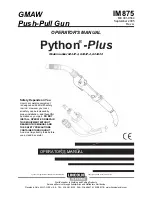
.
20
© Weldclass 2020 | E.&O.E.
7.1.5
Additional Setup for MIG welding with Aluminium
(Weldforce 175MST only)
Welding with aluminium provides a unique challenge, due to the low column strength and surface
friction of the wire. This causes the wire to deform more as it is pushed through the feed mechanism
and the torch wire delivery liner, greatly increasing friction. Because good MIG welding results are
dependent on a smooth wire feed, certain changes must be made to the wire feed system to minimise
friction caused issues.
1.
A shorter MIG Torch will minimize friction and issues. If possible limit length to no longer than 3m
2.
Replace the liner in the MIG Torch with a special Graphite/Teflon/PVC liner (rather than the
conventional steel liner). The Weldclass Universal Graphite liner kit is recommended (P3-CTUL09)
3.
Choose the largest dimeter wire possible that can be used by your machine for your application.
(Ideally 1.0mm or above)
4.
Ensure the wire drive system is fitted with the correct size U-groove drive roller to suit the wire
being used.
5.
Ensure specific Aluminium contact tip to suit chosen wire (or a standard tip in one size oversize,
e.g. 1.0mm aluminium wire, use standard 1.2mm contact tip).
TIP!
For above reasons, it is quite common for operators to have an extra MIG torch
specifically set up for aluminium use, if the machine is used for welding steel as well.
7.1.6
Settings for MIG Welding
1.
Follow above steps for either ‘Gasless Welding Setup’ or ‘Gas MIG Welding Setup’ (whichever is
relevant)
2.
Set welding process selector to ‘MIG’ (
Weldforce 175MST only
)
3.
Rotate Output Knob to choose output power. (Refer to Charts below)
4.
Rotate Output Knob
Inductance (/Arc Force) Knob to fine tune the desired setting. This can be modified to fine tune
the arc characteristics to suit your exact welding application. (Refer to Charts below)
Weldforce 155M
Table 3
*Use chart as guide only, as optimal settings will vary with weld joint type and operator technique.
















































